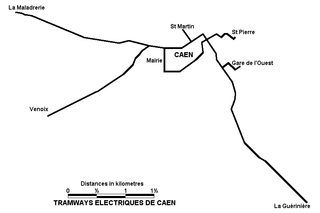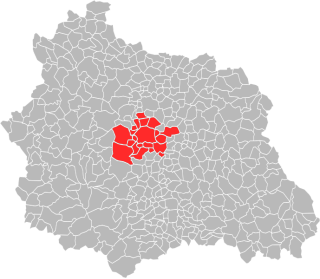This article needs additional citations for verification .(May 2018) |
The Clermont-Ferrand tramway was a tram system in the French city of Clermont-Ferrand between 1890 and 1956. A new system came into operation in 2006.
This article needs additional citations for verification .(May 2018) |
The Clermont-Ferrand tramway was a tram system in the French city of Clermont-Ferrand between 1890 and 1956. A new system came into operation in 2006.
Permission to build a tram line between Montferrand and Royat, with a branch line heading to Clermont-Ferrand station, was granted to engineer Jean Claret (fr) on 27 January 1888, who created the limited partnership Jean Claret & Co. On 13 December 1893 this was replaced by the Clermont-Ferrand Electric Tramway Company (Compagnie des tramways électriques de Clermont-Ferrand), created on 2 May that same year. On 23 December 1911 this company merged with the Clermont-Ferrand-Puy-de-Dôme Railway Company (Compagnie du chemin de fer de Clermont-Ferrand au sommet du Puy-de-Dôme), responsible for running trains to the summit of the nearby Puy de Dôme volcano, to form the Clermont-Ferrand and Puy-de-Dôme Tramway Company (Compagnie des tramways de Clermont-Ferrand et du Puy-de-Dôme).
The first tram line entered service on 7 January 1890. [1] The system was unique in France at the time for using electric power supplied by overhead lines. [2] The system was identical to that used by the Vevey–Montreux–Chillon–Villeneuve tramway in Switzerland. This first line, running on metre-gauge lines, connected the old district of Montferrand with the Place de Jaude in central Clermont. The rolling stock at the time consisted of twenty-two cars, each with two motorised axles for climbing hills. In 1902, a section connecting Jaude to Place Delille (fr) via Place Gaillard (fr) opened, followed in 1913 by a link to the station via the Rue des Salins and a short section heading north from Place Gaillard to the Fontgiève (fr) district. In 1914, a line was opened between the suburb of Beaumont and the city centre, following what is now bus route 4.
Just after the First World War, the rolling stock was modernised. Throughout the first half of the twentieth century, new stock was regularly acquired to tackle increasing demand and serve new lines. In 1932, the system had at its disposal 33 engines and 24 trailers. Following the war, the Beaumont line was extended to Ceyrat. Clermont residents quickly took to travelling out to the countryside on Sundays, and numerous restaurants, bars and cafés sprung up on the main road in Ceyrat. In 1928, a line to Aubière was created, following current bus route 3.
In the wake of the Second World War, the Clermont tram system only suffered minor cuts. Despite its rolling stock dating from the 1930s, the system remained popular and well-appreciated. However, new attitudes towards urban planning obliged authorities to lend priority to the private automobile, and a program of "traffic improvement" was initiated. Wide boulevards were created by removing trees, one-way streets were put in place, traffic lights were erected, and the tramways, which occupied the middle of the thoroughfares and obstructed the flow of cars, were removed. From 1950, the lines were progressively replaced by bus routes.
The network disappeared between 1933 and 1956. The final Clermont tram ran on the 17 March 1956, [3] before being replaced by a bus route. [1] In many places, the rails were simply paved over rather than being removed.
| Route | Length (km) | Opened | Closed |
|---|---|---|---|
| Montferrand–Place de Jaude–Royat | 6.6 | 1890 | 1956 |
| Place de Jaude–Gare | 0.9 | 1890 | 1956 |
| Place Delille–Boulevard de la Pyramide–Place de Jaude | 1.6 | 1895 | 1917 |
| Place Lamartine–Les Quatre Routes | 2.5 | 1912 | 1933 |
| Place Gaillard–Fontgiève | 0.8 | 1913 | 1929 |
| Place de Jaude–Place des Salins–Gare | 2.0 | 1913 | 1956 |
| Place des Salins–Beaumont | 2.2 | 1914 | 1956 |
| Montferrand–Arsenal des Gravranches | 1.3 | 1917 | 1921 |
| Beaumont–Ceyrat | 1922 | 1956 | |
| Place de Jaude–Aubière | 1928 | 1949 |
Current was provided at 500V by a generator in the depot at Montferrand. Originally, power was supplied by copper-covered overhead lines. Trams would attach via trolley pole to a sliding module on the underside of these copper lines. This system was similar to the one used by the Vevey–Montreux–Chillon–Villeneuve tramway since 1888. However, Claret introduced a new innovation to the Clermont system; the current was returned via the rails, rather than by a second overhead line.

Clermont-Ferrand is a city and commune of France, in the Auvergne-Rhône-Alpes region, with a population of 147,284 (2020). Its metropolitan area had 504,157 inhabitants at the 2018 census. It is the prefecture (capital) of the Puy-de-Dôme département. Olivier Bianchi is its current mayor.

The arrondissement of Clermont-Ferrand is an arrondissement of France in the Puy-de-Dôme department in the Auvergne-Rhône-Alpes region. It has 73 communes. Its population is 360,276 (2016), and its area is 884.4 km2 (341.5 sq mi).

Royat is a commune in the Puy-de-Dôme department in Auvergne-Rhône-Alpes in central France. As of 2019, its population was 4,359.

Trams in Caen was the former public transit system serving the city of Caen, France. The original tramway network, operated by Compagnie des tramways électriques de Caen opened in 1901 and closed on 23 January 1937, after which buses took over as the primary means of public transport in Caen.

The Saint-Étienne tramway is a tram system in the city of Saint-Étienne in the Rhône-Alpes (France) that has functioned continuously since its opening in 1881. The first tramway line was steam-operated and was opened by the Chemins de Fer à Voie étroite de Saint-Étienne (CFVE) on 4 December 1881, stretching for 5.5 km between La Terrasse and Bellevue. The CFVE took over the Compagnie des Tramways Électriques de Saint-Étienne lines and discontinued the use of steam in 1912.

Aubière is a commune located in the department of Puy-de-Dôme in the Auvergne-Rhône-Alpes region in southeast France. As of 2017 its population was 10,061.

A rubber-tyred tram is a development of the guided bus in which a vehicle is guided by a fixed rail in the road surface and draws current from overhead electric wires.

Trams in France date from 1837 when a 15 km steam tram line connected Montrond-les-Bains and Montbrison in the Loire. With the development of electric trams at the end of the 19th century, networks proliferated in French cities over a period of 15 years. Although nearly all of the country's tram systems were replaced by bus services in the 1930s or shortly after the Second World War, France is now in the forefront of the revival of tramways and light rail systems around the globe. Only tram lines in Lille and Saint-Étienne have operated continuously since the 19th century; the Marseille tramway system ran continuously until 2004 and only closed then for 3 years for extensive refurbishment into a modern tram network. Since the opening of the Nantes tramway in 1985, more than twenty towns and cities across France have built new tram lines. As of 2024, there are 28 operational tram networks in France, with 3 more planned. France is also home to Alstom, a leading tram manufacturer.

The Clarens–Chailly–Blonay Railway (CCB) or chemin de fer Clarens–Chailly–Blonay was a metre gauge electric railway that operated from 1911 to 1955. At its greatest extent, it ran from the boat landing stage on Lake Geneva in Clarens, via Chailly to Blonay, terminating alongside the station of the Chemins de fer electriques Veveysans (CEV), but not connected to that line.

The Geneva trolleybus system forms part of the public transport network in Geneva, Switzerland. It is the second largest trolleybus system in Switzerland, after the Lausanne system.

The Vevey–Montreux–Chillon–Villeneuve tramway (VMCV) was a metre gauge electric tramway in the Swiss canton of Vaud. It linked the towns of Vevey, Montreux and Villeneuve close to the shoreline of Lake Geneva, and also served the famous Château de Chillon. The line was formed by a merger of the Vevey–Montreux–Chillon tramway (VMC) and the Chillon–Byron–Villeneuve tramway (CBV).

The Montreux/Vevey trolleybus system, also known as the Vevey–Villeneuve trolleybus line, forms part of the public transport network in Montreux and Vevey, in the canton of Vaud, Switzerland. It comprises a single 12.75 km (7.92 mi) long trolleybus route along the length of the Riviera vaudoise on the north shore of Lake Geneva.

The Clermont-Ferrand tramway is a transit system located in the city of Clermont-Ferrand in the Auvergne-Rhône-Alpes region of France. It is a Translohr system, meaning it is guided by a single rail and powered by electricity from overhead wires.

Jaude Square is a major city square and meeting place in the centre of Clermont-Ferrand, France. It is bordered by Rue Blatin on the North and Avenue Julien on the south. The square is home to many attractions, such as the Opera Theatre, the Jaude Shopping Mall and Saint-Pierre-des-Minimes Church.
The following is a timeline of the history of the city of Clermont-Ferrand, France.

Clermont Auvergne Métropole is the métropole, an intercommunal structure, centred on the city of Clermont-Ferrand. It is located in the Puy-de-Dôme department, in the Auvergne-Rhône-Alpes region, central France. It was created in January 2018, replacing the communauté urbaine that had replaced the previous communauté d'agglomération Clermont-Communauté in January 2017. Its area is 300.6 km2. Its population was 294,127 in 2018, of which 146,734 in Clermont-Ferrand proper.

Lausanne, a city in western Switzerland and a cultural and commercial centre, has returned its tramway as a modern tram system.
France Bleu Pays d'Auvergne is a generalist public service radio station. It broadcasts in the departments of Puy-de-Dôme, Allier, Cantal and most of western Haute-Loire.
The Hanscotte system was a design for railway locomotives and track using, in addition to the conventional load-bearing driving wheels, pairs of horizontal driving wheels mounted underneath the locomotive and pressing inwards upon a central rail, to improve adhesion and traction. The engineer Jules Hanscotte developed the system while working for Société de construction des Batignolles (SCB), Paris, in about 1904.
C'est à Clermont-Ferrand qu'a été installé le premier tramway électrique inauguré en France